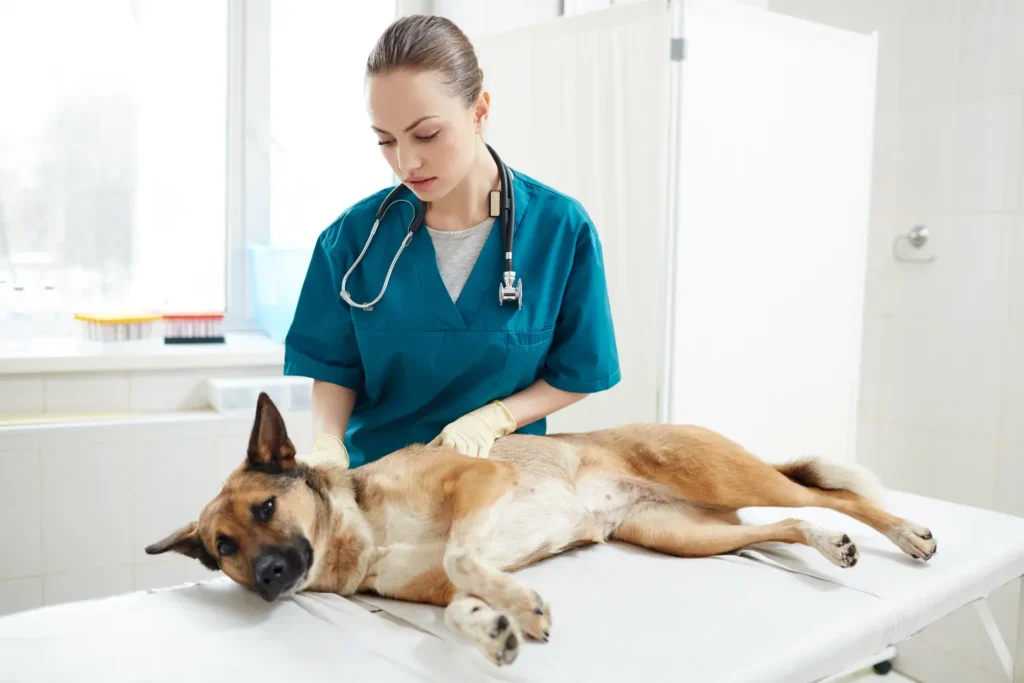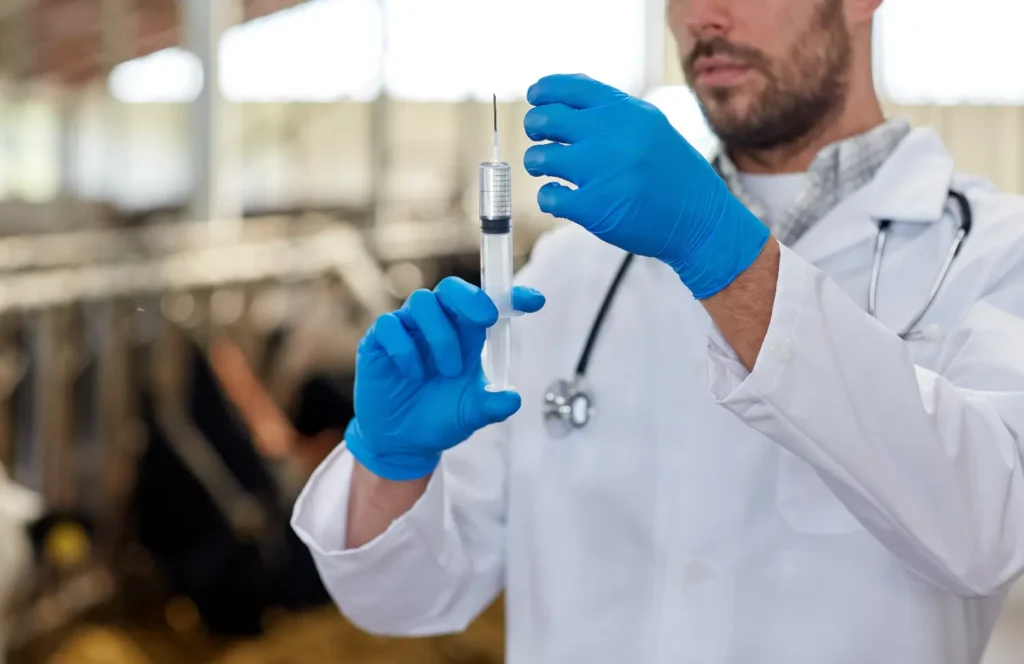
Tetanus is a disease that produces spasms in animals and results from the action of a neurotoxin produced by Clostridium tetani, an anaerobic spore-forming Gram-positive bacterium. When these bacteria enter necrotic tissue, they produce toxins that attack the nerves and cause muscle stiffness and spasms that progressively worsen.
The disease is not uncommon in cattle and horses, the bacteria are found in dead tissue and can enter the animal's body through a puncture wound, almost all mammals are susceptible to tetanus, but dogs are relatively resistant to it. disease, localized tetanus first develops and then general rigidity progresses as the disease progresses, signs usually appear 10 to 14 days after wound infection.
Symptoms
Tetanus is a disease caused by a poison produced by the bacteria Clostridium tetani, which enters a deep or penetrating wound; Once in the wound, these bacteria germinate and produce a neurotoxin called tetanospasmin.
This toxin, which binds to the motor nerves that control the muscles, is released from the bacterial cell, enters the axons (filaments that extend from the nerve cells), and travels up the axon in the spinal cord or trunk from the brain through a process called retrograde intraneuronal transport.
Once the toxin is released, it binds to presynaptic nerve terminals and interferes with the release of inhibitory neurotransmitters, which normally prevent muscle spasms from occurring. It also blocks the action of acetylcholine on postsynaptic receptors, causing a lack of transmission of impulses at the level of the central nervous system.
As a result, even minimal stimulation of the skin, such as light or sound, can cause tetanic muscle spasms, it is for this reason that it is necessary to keep a patient with tetanus in a dark room and minimize sounds and bright lights to reduce the intensity of spasms.
Infection with the bacteria that causes tetanus produces a progressive disorder of the central nervous system, the incubation period of tetanus is 3 to 21 days and symptoms usually begin five to ten days after injury, but can occur as soon as about three days after infection.
En una forma localizada, los síntomas consisten en espasmos musculares que comienzan en el lugar de la lesión o en el área alrededor de la herida, este tipo de tétanos es más fácil de tratar que la forma generalizada, pero aún así puede progresar a una forma generalizada de tétanos, en la que todos los grupos de músculos esqueléticos se ven afectados con espasmos, este es el tipo más grave de tétanos y suele ser mortal.
A menudo, en las últimas etapas del tétanos, los animales afectados desarrollan en la cara, síntomas que incluyen frente arrugada (llamada sonrisa sardónica o risus sardonicus), orejas erguidas y mandíbula rígida (llamada trismo), los movimientos involuntarios de los músculos de la mandíbula hacen que los dientes se mantengan bien cerrados, lo que provoca la incapacidad de masticar, los perros con esta forma grave de tétanos con frecuencia no pueden tragar y como resultado, comienzan a babear.
Otros signos de tétanos en perros pueden incluir elevación del tercer párpado (llamado prolapso de membrana nictitante), disfunción autonómica (que incluye bradicardia, taquicardia) y fiebre, la piel puede volverse de color azulado, los perros que ya no pueden caminar se mantendrán rígidos en lo que se conoce como postura de caballete.
El tétanos puede causar síntomas gastrointestinales graves, como vómitos y diarrea, y puede interferir con la respiración, la afectación de los músculos esqueléticos en el tétanos además de producir espasmos, también puede provocar fracturas óseas, los casos graves que afectan los músculos de la garganta y el diafragma pueden provocar insuficiencia respiratoria y la muerte. Si crees que tu mascota pueda sufrir de esta enfermedad te recomendamos consutar con nuestros médicos veterinarios.
Como ocurre con la mayoría de las enfermedades infecciosas, no existe un análisis de sangre sencillo para diagnosticar el tétanos, una historia cuidadosa del animal afectado y un cultivo positivo de la herida del sitio anatómico apropiado deben conducir a un diagnóstico presuntivo.
Es importante distinguir entre los tétanos y otras afecciones que pueden provocar signos similares de rigidez muscular y espasmos, como la enfermedad del músculo blanco en rumiantes jóvenes, Sarcostemma viminalis spp. en bovinos, ovinos y caprinos, o Cyanthum spp. en caballos y cerdos, además, los signos del tétanos pueden confundirse con los de shock séptico o hipocalcemia. Puedes leer sobre otras infecciones bacterianas en animales.

Tratamiento de los espasmos
La vacuna contra el tétanos, que se administra en forma de inyección y luego se refuerza, ayuda a proteger al animal de la neurotoxina mortal producida por C. tetani, la vacunación inicial generalmente requiere dos inyecciones y se recomiendan refuerzos anuales, la vacuna contra el tétanos es muy eficaz y la enfermedad rara vez se ve en países con altas tasas de inmunización y prácticas médicas sólidas para el cuidado de las heridas y el parto.
If the condition is diagnosed early, it can be treated with tetanus antitoxin, which binds to the toxin and destroys it. However, tetanus antitoxin cannot release the toxin that is already bound to the nerves, penicillin is also given to prevent the new growth of Clostridium tetanise and the animal should be placed in a dark room and given sedatives and muscle relaxants to help control spasms.
Intensive nursing care is needed to ensure that the affected animal does not become dehydrated and is fed as soon as possible, even if it cannot open its mouth to do so. Nursing care includes hydration and soft bedding to prevent bedsores, depending on the condition. Symptom severity improvement is usually seen within the first week of treatment, but complete recovery can easily take a month or more.
The use of oxidizing disinfectants such as iodine and chlorine on the wound is recommended to kill any C. tetani spores present, all animals should be vaccinated against tetanus according to current recommendations, and pregnant mares should be vaccinated in the last 6 weeks of gestation. , animals that have recovered from tetanus do not develop good immunity and must be vaccinated again against the disease.
Affected animals should be treated as soon as possible after diagnosis, veterinary surgeons should use aseptic techniques, including disinfecting the navel after birth and performing surgical procedures such as castration, tail docking and debuttoning under controlled conditions and with sterilized instruments, they will significantly reduce the risk of tetanus in livestock.
Prevention
Most pet owners have heard of tetanus and have probably had a tetanus vaccine in the past, they may also have heard about the spasm-causing disease through the news or from friends who were affected by it. It is an extremely serious disease that can be fatal, but can be prevented.
Tetanus is caused by the bacteria Clostridium tetani, which can be found throughout the world and is especially common in cultivated and fertilized soils. The spores are resistant to degradation and can survive for months in anaerobic conditions. They can be found in feces. of many species of animals, including cattle and horses, as well as humans.
Young dogs or puppies often pick up contaminated dirt and foreign debris with their mouths, these items may include rusty nails, pins and other foreign objects from outside or their environment; The bacteria then enter the body through a wound or when a scab forms that irritates the skin, where the bacteria grow and produce tetanospasmin, the toxin that produces the symptoms and spasms of tetanus in dogs.
Prevention is key and includes keeping your pet's wounds clean and removing any contaminated debris as soon as possible after an injury or surgery; In order for your pet to be healthy and free of diseases, it is recommended to follow some simple tips to care for your pets.
